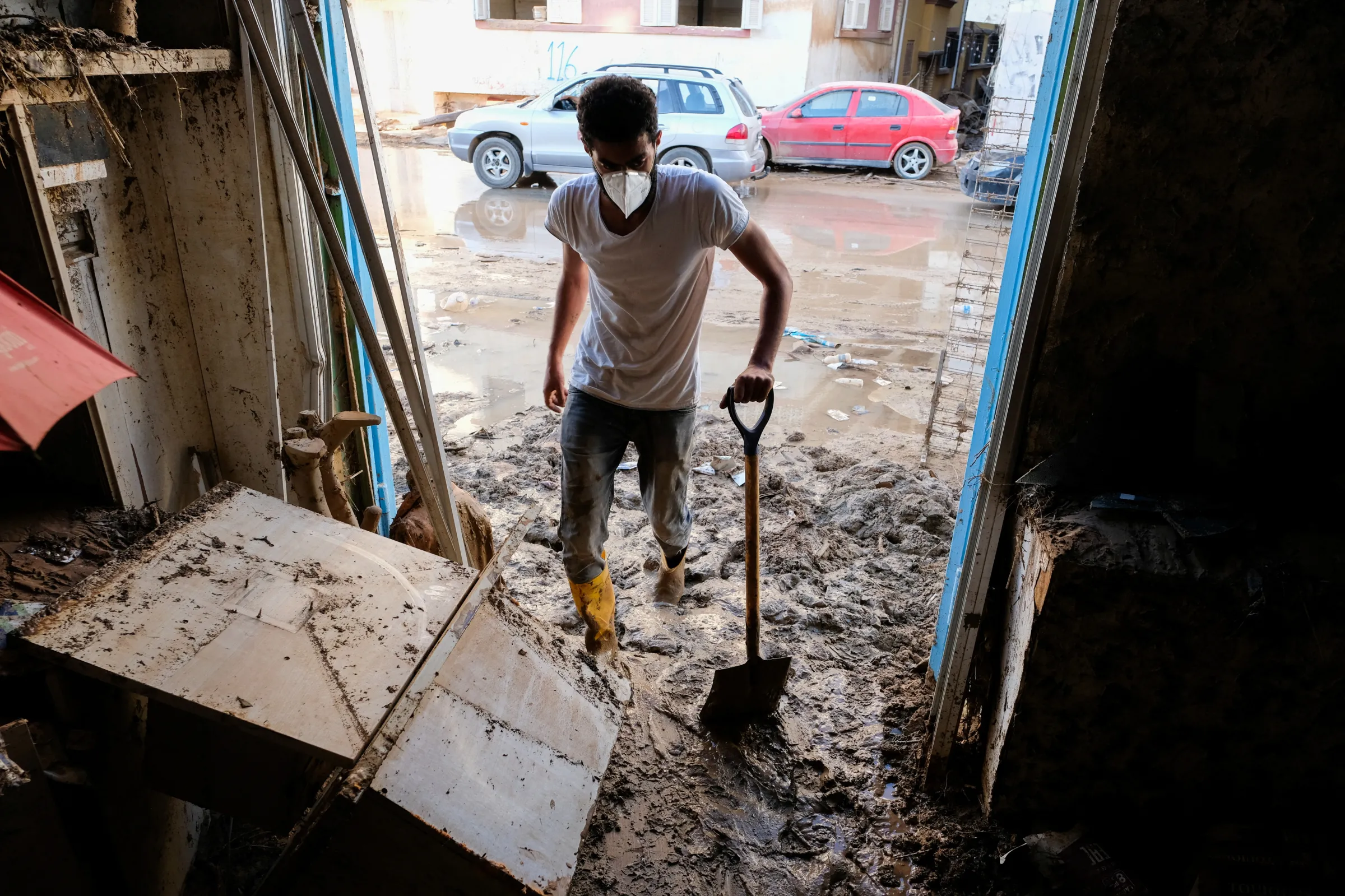Making climate funds fit for purpose in fragile countries

A man clears mud covering the floor of his pharmacy, which was affected by fatal floods, in Derna, Libya, September 28, 2023. REUTERS/Esam Omran Al-Fetori
The world must reform international climate finance to better serve the people most affected by climate change in fragile contexts
Mauricio Vazquez is head of policy at think tank ODI's Global Risks and Resilience programme and Hodan Osman is president of the Development and Reconstruction Bank of Somalia.
At the annual meetings of the World Bank and International Monetary Fund this month, we will likely hear more commitments to support the world's most climate vulnerable. Yet there is a persistent blind spot in climate finance and action.
New analysis shows that fragile and conflict-affected countries receive only one quarter of the finance they need for climate adaptation, despite being among the most vulnerable to climate change.
This shortfall has devastating implications. In 2022, a child born in South Sudan was 38 times more likely to be internally displaced by climate-related disasters than a child born in Europe or North America. Yet they will receive only a fraction of the support that flows to more stable contexts.
The uncomfortable truth behind this conflict blind spot is simple. The cost of inaction on climate change is being paid by the world’s most vulnerable people – so there is little incentive for change.
This cannot continue. It is not enough to pledge money, or to unlock resources via finance engineering, if that money is not being spent and - more importantly - spent on projects that address the most critical climate vulnerabilities of those left behind.
Mounting costs
The costs of climate hazards are mounting in fragile countries. Already, many African countries are losing 2-5% of gross domestic product (GDP) and diverting up to 9% of their budgets to respond to climate extremes.
If we don't act in the next 10 years, we risk locking countries into an endless cycle of coping with crises, leaving them with no resources to invest in anticipating, absorbing and adapting to future shocks.
Somalia is a case in point. The country receives just over $300 million in climate-related funding each year, or just 0.6% percent of the amount the government says it needs to adapt.
By contrast, between 2011 and 2023, Somalia received $1.1 billion each year in humanitarian aid funding. The discrepancy highlights a damning failure at the heart of the global development system: it is easier to unlock finance in the aftermath of disasters than it is to invest in preventing them.
But Somalia cannot afford to wait until its next devastating, climate-induced drought for support. Climate-related floods and droughts could cost Somalia up to $100 billion in losses and damages by 2050 unless it receives more finance for adaptation and climate-resilient socio-economic development.
The courage to reimagine risks
To have results in 10 years, we need to enable the right investments now. This means urgent action needs to be taken across three areas.
First, climate funds and multilateral institutions, including the World Bank, must get real about the costs of inaction in fragile and conflict-affected countries.
While the risks of investing in these places are very real, inaction and the persistent lack of investment also generate costly risks – as estimates about future loss and damage in Somalia make clear. Acknowledging these risks and putting them at the forefront of planning will make it harder to select the option of “doing nothing”.
Secondly, more work needs to be done to realign funds’ internal incentives by rewarding those who do more in fragile contexts and establishing indicators for success that are centred on people, and not just on returns on investment.
This will also require a reassessment of what ‘successful projects’ look like. Projects in fragile and conflict-affected settings tend to cost more, take longer, and be smaller, while internal incentives often prioritise efficiency, speed, and scale. We must change these internal structures to enable new decision-making and foster fresh attitudes towards fragile contexts.
Finally, funds need to build their capacity to work in fragile settings. A common excuse for inaction is that countries like Somalia do not have capacity to access, receive, and deliver climate finance. But in an increasingly conflict-affected world, funds must also adapt: amending their rigid application requirements and slow-moving timeframes.
Embracing discomfort
The timing could not be more critical. For each year that we do not act, the chances of protecting people from future climate impacts lessen significantly.
Ultimately, we may reach a point where the only tool available to us will be to provide relief.
At the World Bank meetings and beyond, we need to see real movement from climate finance providers to embrace the inconvenient truth: that our current climate finance system is not fit for purpose when it comes to supporting the world’s most climate vulnerable.
Any views expressed in this opinion piece are those of the author and not of Context or the Thomson Reuters Foundation.
Tags
- Extreme weather
- Adaptation
- Climate policy
- Climate inequality
- Climate solutions
Go Deeper
Related
Latest on Context
- 1
- 2
- 3
- 4
- 5
- 6
Most Read
- 1
- 2
- 3
- 4
- 5


















